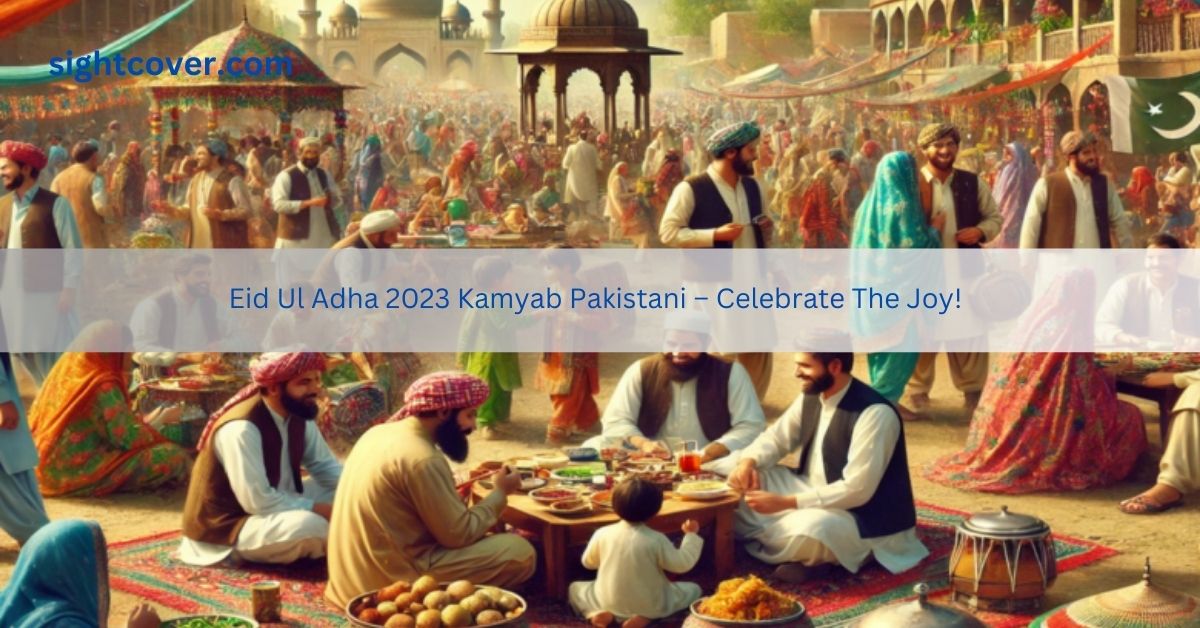Imagine vibrant markets buzzing with excitement, families coming together in joyous reunions, and the spirit of generosity lighting up communities—this is how Pakistan celebrated Eid ul Adha 2023, a truly “Kamyab Pakistani” event. Dive into our article to explore the rich traditions, heartwarming stories, and unique ways Pakistanis have adapted their celebrations in modern times.
Eid ul Adha 2023 in Pakistan, celebrated as “Kamyab Pakistani,” was marked by vibrant markets, traditional feasts, and a strong sense of community. Families came together for the sacrificial ritual, shared meals, and engaged in acts of charity, embodying the festival’s spirit of generosity and unity.
The Glimpse Of Eid Ul Adha 2023 – Have A Look Into!
Eid ul Adha 2023 was a vibrant tapestry of Pakistan’s traditions, faith, and community spirit. Streets buzzed with activity as people prepared for the grand celebrations. Markets were alive, with sellers showcasing sacrificial animals, from goats to camels, each symbolizing the devotion and obedience to God that Eid ul Adha commemorates. Families and friends gathered to participate in the ritual sacrifice, reflecting on Prophet Ibrahim’s unwavering faith.
The celebrations extended beyond religious observance. Houses were adorned with festive lights, and kitchens were bustling with the preparation of traditional dishes. The air was filled with the aroma of biryani, kebabs, and sweets, creating an atmosphere of joy and togetherness. People visited each other’s homes, shared meals, and exchanged gifts, strengthening social bonds and creating lasting memories.
Eid Ul Adha 2023 Kamyab Pakistani Highlights – Explore Now!
The “Kamyab Pakistani” theme of Eid ul Adha 2023 highlighted the spirit of success and prosperity. One of the most notable aspects was the robust participation in the Qurbani ritual, where families ensured the meat was distributed to needy people, embodying the festival’s essence of charity and generosity. The event saw communities coming together, with many organizing collective sacrifices to ensure everyone could partake in the celebrations.
Social media plays a significant role in connecting people. Platforms like Instagram and Facebook were flooded with posts sharing the joyous moments of Eid. From pictures of beautifully decorated homes and sumptuous feasts to videos of the Qurbani process, the digital sphere was abuzz with the festive spirit. This virtual sharing not only kept the diaspora connected but also showcased Pakistan’s rich cultural heritage to a global audience.
Connection Of Sacrifice With Eid Ul Adha – Pay The Ritual!
The act of sacrifice, or Qurbani, is the cornerstone of Eid ul Adha. This ritual, rooted in the story of Prophet Ibrahim’s willingness to sacrifice his son, is a profound demonstration of faith and obedience to God. In Pakistan, this tradition is observed with great reverence. Families purchase animals weeks in advance, ensuring they meet the Islamic criteria for sacrifice.
On the day of Eid, after the special prayers, the sacrifice is performed. The meat from the sacrificed animals is divided into three parts: one for the family, one for friends and relatives, and one for people with low incomes. This distribution embodies the spirit of sharing and community, ensuring that everyone, regardless of their financial status, can enjoy the blessings of Eid. This act of giving strengthens social bonds and underscores the values of compassion and generosity.
Traditions And Rituals Associated With Eid Ul Adha 2023 – What Muslims Do!
Eid ul Adha is steeped in traditions and rituals that reflect its religious and cultural significance. The day begins with Muslims attending a special prayer service, often held in large open spaces to accommodate the congregation. Dressed in their finest clothes, people greet each other with “Eid Mubarak” and exchange heartfelt wishes. This prayer is a moment of unity and reflection, emphasizing the community’s collective faith.
Following the prayer, the ritual of Qurbani takes place. This is a time for families to come together and participate in the sacrifice, a practice that teaches patience, devotion, and humility. The day is filled with visits to friends and relatives, where sumptuous meals are shared. Traditional dishes prepared from the sacrificial meat are the highlight of these gatherings, fostering a sense of camaraderie and joy.
The Glimpse Into The Cattle Market – Get The Animal!
The cattle markets are a bustling highlight of Eid ul Adha preparations in Pakistan. In the weeks leading up to the festival, markets like Karachi, Lahore, and Islamabad become lively hubs where people gather to select their sacrificial animals. Sellers display a variety of animals, from goats and sheep to cows and camels, each carefully groomed and presented to attract buyers.
Selecting an animal is both a family affair and a social event. Buyers look for animals that meet religious requirements while ensuring they are healthy and well-cared for. The negotiation between buyers and sellers adds to the market’s vibrant atmosphere. This tradition not only underscores the economic significance of Eid ul Adha but also highlights the meticulous care that goes into performing the Qurbani ritual.
Animals Which Are Being Sacrificed On Eid Ul Adha!
On Eid ul Adha, various animals are chosen for the Qurbani ritual, each symbolizing different aspects of the tradition. Commonly sacrificed animals include goats, sheep, cows, and camels. These animals are selected based on their health and adherence to Islamic guidelines, ensuring they are free from defects and of a certain age.
The choice of animal often depends on regional preferences and economic considerations. In rural areas, larger animals like cows and camels are more common, usually shared by multiple families due to their size. In urban areas, goats and sheep are popular due to space constraints. Regardless of the type, the sacrifice of these animals is a profound act of faith and devotion, reminding Muslims of the importance of obedience to God and the spirit of sharing with others.
Eid Ul Adha 2023 Preparations:
Offer The Eid Prayer:
Offering the Eid prayer is a significant part of Eid ul Adha celebrations. Muslims gather at mosques or designated prayer grounds on the morning of Eid, dressed in their finest attire, to perform the special Eid prayer. This prayer, usually conducted in congregation, signifies unity and collective devotion. The prayer includes a sermon reflecting on Islam’s teachings and the significance of sacrifice, drawing inspiration from the story of Prophet Ibrahim.
Perform Sacrifices:
The act of performing sacrifices, known as Qurbani, is the highlight of Eid ul Adha. This ritual commemorates Prophet Ibrahim’s willingness to sacrifice his son in obedience to God, a test of faith that was met with divine mercy. In Pakistan, the sacrifice is typically performed after the Eid prayer. Families gather to carry out this solemn ritual, ensuring that the animals meet all religious criteria, such as being healthy and of a certain age.
The Kamyab Pakistani Perspective:
Eid ul Adha 2023 was celebrated with the theme “Kamyab Pakistani,” emphasizing success and resilience. This perspective highlighted the collective efforts of Pakistanis to overcome challenges and celebrate their cultural and religious heritage with pride. The theme resonated with the community spirit, as people engaged in acts of charity, ensuring that the blessings of Eid reached everyone, especially those affected by economic hardships.
The Traditional Eid Ul Adha Dishes – Celebrate The Culinary Delight!
Eid ul Adha is a time for spiritual reflection and communal harmony. It is also a celebration of culinary traditions that bring families together. The preparation and enjoyment of various traditional dishes rich in flavor and cultural significance mark the festival.
Among the most beloved dishes are biryani, a fragrant rice dish cooked with meat and a blend of spices, and various types of kebabs marinated and grilled to perfection. These dishes are often prepared in large quantities to share with family, friends, and neighbors, reflecting the spirit of generosity central to Eid celebrations.
In addition to savory dishes, sweets play a crucial role in the Eid ul Adha feast. Desserts such as sheer khurma, a vermicelli pudding cooked with milk, dates, nuts, and various types of halwa are staples at Eid gatherings. These sweet treats are enjoyed at home and given as gifts to visitors, symbolizing hospitality and the sharing of joy.
Other Family Celebrations On Eid – The Community Gatherings!
Eid ul Adha is a time for families to come together and celebrate in many ways that extend beyond the religious rituals. Community gatherings are a hallmark of the festival, where extended families and friends meet to share meals, exchange gifts, and enjoy each other’s company.
These gatherings often begin with the morning Eid prayer, after which families visit each other’s homes, spreading the festive cheer. Visiting relatives and friends is a cherished tradition that strengthens social ties and ensures that all feel the spirit of Eid.
In addition to home visits, many communities organize larger events, such as communal feasts, where members come together to share the sacrificial meat and partake in a collective meal.
Spirit Of Giving On Eid – The Charitable Activities!
The spirit of giving is deeply embedded in the celebration of Eid ul Adha, reflecting the festival’s core values of compassion, generosity, and social responsibility. One of Eid’s most significant charitable activities is the distribution of meat from the sacrificial animals. This meat is divided into three parts: one for the family, one for friends and relatives, and one for the poor and needy.
This act of sharing ensures that even the less fortunate can enjoy the blessings of Eid, promoting a sense of equality and community solidarity. Beyond meat distribution, many Muslims engage in additional acts of charity during Eid ul Adha. Donations to charities, volunteering at community kitchens, and providing financial support to those in need are standard practices.
These activities are not limited to the days of Eid but often extend throughout Dhul-Hijjah, the Islamic month during which Eid ul Adha occurs. By participating in these charitable acts, Muslims demonstrate their commitment to helping others and living out the principles of their faith in practical ways.
FAQ’s:
1. How is the sacrificial meat distributed?
The meat is divided into three parts: one for the family, one for friends and relatives, and one for the poor and needy.
2. What are some traditional dishes prepared for Eid ul Adha?
Traditional dishes include biryani, kebabs, and sweet treats like sheer khurma and halwa.
3. How do families celebrate Eid ul Adha besides the sacrifice?
Families celebrate by visiting relatives, sharing meals, exchanging gifts, and engaging in community gatherings.


